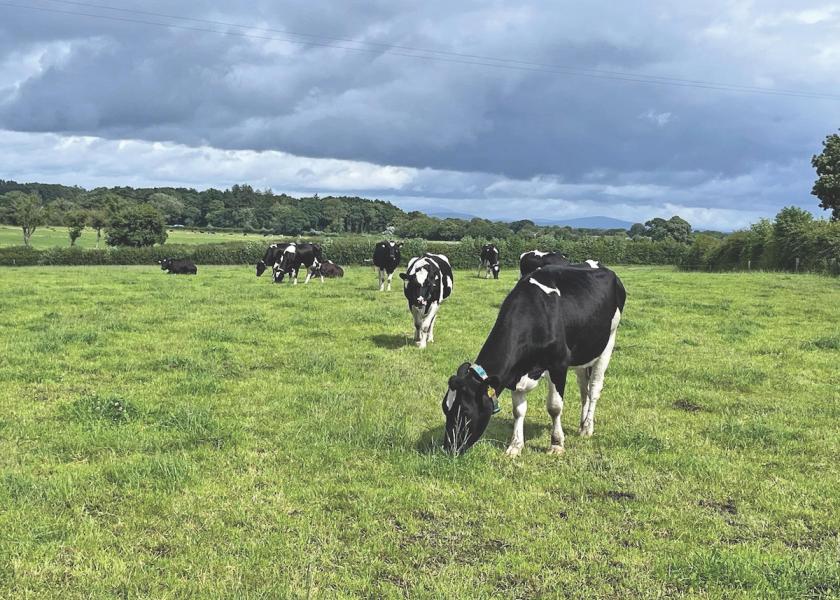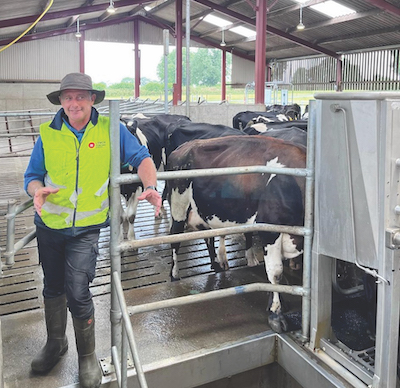Back to the Future for Dairying in Ireland

At age 50, Irish farmer Noel Lynch made a major life move counter to those of most producers in his demographic: he entered into dairying.
It actually wasn’t his first foray into dairy management. Lynch grew up milking cows on the 84-acre farm he calls home in the Kilkenny region of southeast Ireland. The farm has been in his family for 5 generations. Lynch is the sixth and his son, Alfie, 15, the seventh.
In 2002, Lynch was busily traveling the world as a sales representative for a dairy nutrition company. His father, who was ready to slow down, sold the dairy cows and converted to beef production.
But Lynch eventually felt the tug of his Irish roots and returned to the farm to raise his family. He managed the beef herd and started a now-bustling fencing company that employs 6 other workers. Then, in the interest of capturing higher margins from his limited acreage, he dove back into dairying, milking his first cows – this time, with a robot -- in January 2023.
A Dairy Resurgence
The dairy industry in Ireland has exploded since the European Union (EU) lifted its milk quota system in 2015, according to Gerry Giggins, an Irish ruminant nutrition consultant. Giggins traverses the entire island country – which is about the size of the state of Indiana -- and has worked in the industry for decades. He now also runs Farm Tours Ireland, a travel business specializing in visits to authentic Irish farms.
“We grew from about 950,000 head of milking cows then, to 1.6 million today,” shared Giggins. “Irish farmers have a long tradition of producing high-quality dairy products, and they love doing it.”
The temperate climate and 30-40 inches of annual rainfall mean it’s almost always like springtime in Ireland. It’s the perfect scenario for growing grass, which is the basis for making one of the country’s most popular and world-renown dairy products, Irish grass-fed butter.
Dairy leads the way in agricultural exports from Ireland, with about 70% of its milk being shipped abroad. “There are about 5 million people in Ireland, but we feed 60 million people worldwide,” Giggins noted. The country’s trade with China has boomed in recent years, with Irish dairy farms supplying more than a third of all of China’s baby formula.
But the winds of change continue to blow in Ireland. Farming practices there are heavily influenced by direct subsidy payments from the EU, of which most of the country is a part. Compliance with the Paris Agreement dictates that participating countries arrive at “net zero” carbon dioxide emissions by 2040.
In an attempt to achieve that compliance, Ireland is raising its animal-to-land ratio so that farmers like Lynch will have to have more acres over which to spread the density of their animals, or reduce animal numbers. The move is expected to shave cattle numbers in the country by about 200,000 head.

Innovation Meets Regulation
Lynch currently milks 65 British Friesian cows and also custom-grazes 80 heifers for a neighboring, 400-cow dairy. With that additional pasture space, he will be able to pursue his goal of doubling his herd size by 2025. Beyond that, expansion may be challenging. Lynch reported land rarely comes up for sale, and currently fetches $25,000-26,000 per acre. Cash rent is about $500 per acre.
The EU subsidies provide steady income and risk protection. Yet farmers also are tethered by regulations that are tedious compared to American standards. “I have to have a license to spray absolutely every chemical on my farm, and to run a chain saw,” he shared. “I pay a recycling fee when I purchase silo plastic, then pay another fee to have it hauled away.”
Government-driven electronic identification allows 100% traceability of cattle. Every animal must be accounted for at the beginning and end of the year, and all sales must be conducted through official channels – no exchanging of animals between neighbors, and no on-farm butchering that is not documented by a certified abattoir.
Lynch also isn’t impressed with the government’s logic on climate change. “One flight from Dublin to New York City produces more carbon than an Irish dairy farm with 120 cows for an entire year,” he stated. “A country’s ability to grow its own, high-quality food is not something that should be taken for granted.”
Still, he is grateful for the opportunity to farm, and is contagiously enthusiastic about his family’s future in dairying. “My son is mad about farming,” he declared. “It’s a good life, and we’re going to keep striving at it.”







